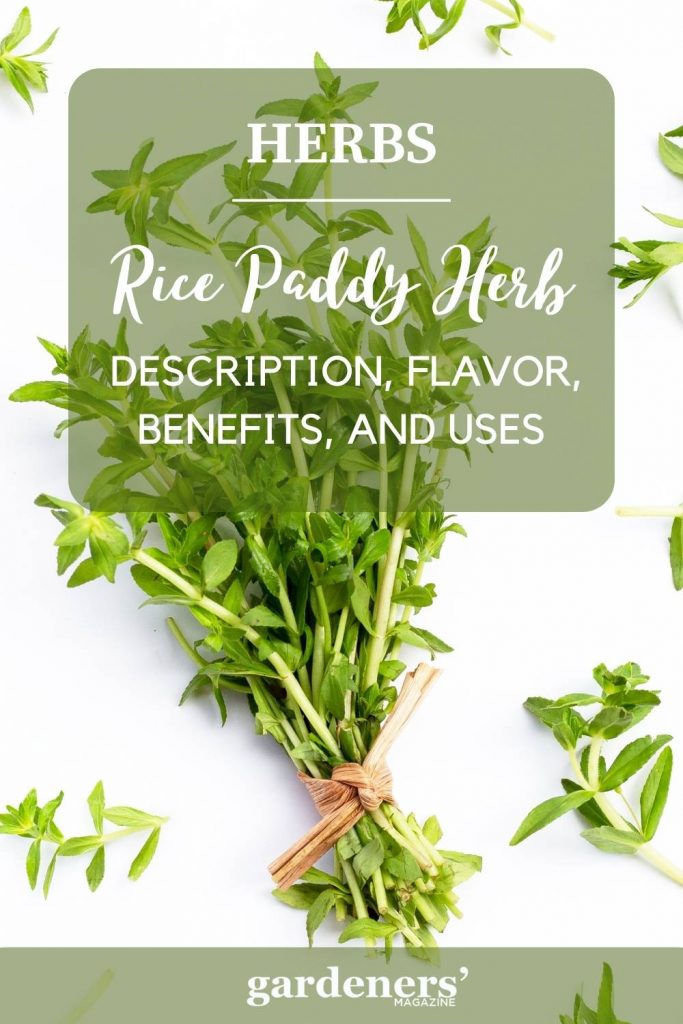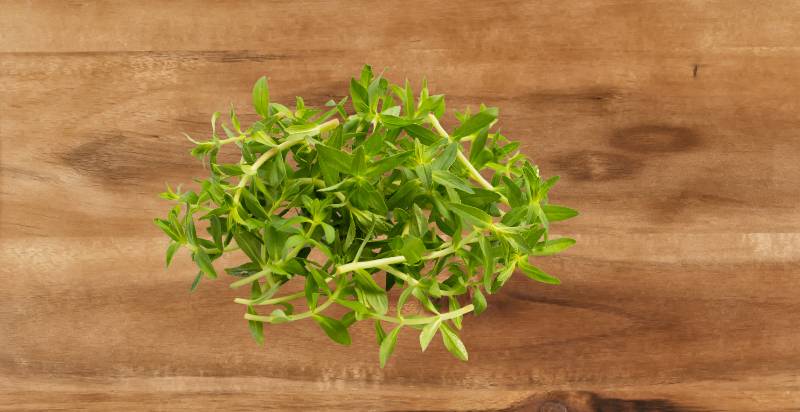Rice Paddy Herb (Ngo Om) is a popular herb used for centuries in Southeast Asia, especially Vietnam. It is also known as Eryngium Foetidum or ‘Ngổ’ in Vietnamese. This herb has many medicinal benefits and can be used to treat a variety of ailments. It has an aroma similar to that of coriander and a bitter taste. The leaves are used in cooking, while the roots can be boiled for tea. It is often added to soups and salads to enhance their flavor. Here is a comprehensive guide to Rice Paddy Herb (Ngo Om) and its many benefits.
What is Rice Paddy Herb (Ngo Om)?
Rice Paddy Herb (Ngo Om) is an annual grass-like herb native to Southeast Asia. It is widely used in Vietnamese cuisine as a flavorful addition to soups, stews, and salads. The plant has long been prized for its numerous medicinal properties, including improving digestion, reducing inflammation, and supporting the liver. In addition, Rice Paddy Herb has been used to treat respiratory infections and to reduce fever. It is also thought to have antifungal, antimicrobial, and antiviral properties, making it an excellent addition to any natural health regimen.

History and Origin of Rice Paddy Herb
Rice paddy herb, or Ngo Om in Vietnamese, is a species of aquatic grass native to Southeast Asia. It has been used for centuries in traditional medicine and cuisine due to its unique flavor and aroma. The plant grows in flooded fields known as “paddies,” a common sight throughout the region. In Vietnam, it is also known as “wetland grass” or “paddy grass.” Rice paddy herb was first documented in the 15th century when it was used for medicinal purposes. It has been used to treat various ailments such as diarrhea, fever, and stomach issues.
Rice paddy herb is easy to grow and requires little maintenance. Its hardiness allows it to thrive in warm, wet environments and can be grown in most parts of the world with the right soil conditions. With a little bit of love and care, you can enjoy this special herb’s unique flavor and aroma.
Description of the Rice Paddy Herb
Ngo Om, or Rice Paddy Herb, is an herbaceous perennial plant in tropical and subtropical climates. It grows to a height of 50-60 cm, with a sprawling and leafy structure. Its stems are square in cross-section, and the leaves are broadly lanceolate, each 7-15 cm long and 2-4 cm wide.
The flowers are small and white, clustered in axillary inflorescences, and the fruit is a small capsule containing four seeds. Ngo Om is traditionally an aromatic ingredient in Vietnamese cuisine, usually added to soups, salads, and stir-fries. It has a mild, herbal flavor and is said to aid digestion.
Flavor Profile of Rice Paddy Herb (Ngo Om)
Rice Paddy Herb (Ngo Om) has a refreshing, grassy aroma and flavor with an earthy undertone. Its texture is slightly crunchy, and its taste combines sweet, bitter, tart, and salty flavors. It can be used as an ingredient in various dishes, including soups and salads. When cooked, Rice Paddy Herb (Ngo Om) has a soft, buttery texture and is often used as a garnish or for flavoring stews. It pairs well with vegetables, poultry, seafood, and pork dishes. Rice Paddy Herb (Ngo Om) also makes teas and herbal infusions for health benefits.
Health Benefits of Rice Paddy Herb (Ngo Om)
Rice Paddy Herb (Ngo Om) has many health benefits due to its high content of essential vitamins and minerals such as magnesium, calcium, iron, zinc, and vitamin C. It is known to have anti-inflammatory and analgesic (pain relieving) properties which can help reduce the symptoms of various ailments. The herb is also known to have antioxidant properties, meaning it can help protect cells from damage caused by free radicals.
Cultivation of the Rice Paddy Herb (Ngo Om)
Cultivation of the Rice Paddy Herb commonly known for its strong aroma, Ngo Om has been used in traditional Vietnamese cuisine and medicine for centuries. It is a member of the genus Limnophila aromatic and is classified as an aquatic herb. Ngo Om can be found in rice paddies throughout Vietnam and neighboring countries. Ngo Om can be planted in most standard soil types and prefers moist, well-drained soils. It should be grown in a sunny or partially shady area and can tolerate some flooding. The plant is grown from cuttings or seeds planted in rows at least 30 cm apart. It requires frequent watering and fertilization to ensure optimal growth.
Ngo Om is an essential ingredient in Vietnamese cuisine and an excellent garden addition. It is easy to grow and requires minimal care, making it a great choice for novice gardeners. With its unique flavor and aroma, Ngo Om will surely become a favorite in your garden.
Harvesting of the Rice Paddy Herb (Ngo Om)
Ngo Om, known as Rice Paddy Herb, is a common ingredient in many Southeast Asian countries. It has been widely grown and harvested for centuries. The harvesting process of Ngo Om is relatively simple. First, the rice paddy fields are checked to ensure the Ngo Om is ready to be harvested. The herb should be cut at the stem and allowed to dry for a few days before being collected. Once the herb has dried, it is collected in large baskets and taken to a processing area.
The Ngo Om is weighed and measured in cm at the processing area. The length of each stem should be between 5 to 10 cm, and the width should be around 0.5 cm to ensure that the herb is suitable for culinary use. After this, the Ngo Om is cleaned and sorted into different grades.

Where Does Rice Paddy Herb (Ngo Om) Grow?
Rice Paddy Herb (Ngo Om) is a common herb in many parts of Southeast Asia. It grows well in humid and wet climates like the tropics and subtropics. It is widely cultivated in Thailand, Vietnam, Laos, Myanmar, Cambodia, India, and Indonesia. In Thailand, it is commonly grown in the Central Plains of Thailand and the Isan region. In Vietnam, it is grown in parts of the Mekong Delta and parts of the Red River Delta.
In Laos, it is grown mainly in the southern region. It is grown mainly in the Ayeyarwady Delta and Bagan region in Myanmar. In Cambodia, it is grown mainly in Kampong Speu Province, and in India, it is grown mainly in the states of Haryana, Punjab, Uttar Pradesh, and West Bengal. It is grown in parts of Kalimantan, Sumatra, and Java in Indonesia.
What Must You Remember when Buying Rice Paddy Herb (Ngo Om)?
- Choose the freshest Rice Paddy Herb (Ngo Om) available – Look for herbs with bright green leaves and a fresh, fragrant smell. Avoid herbs with wilted leaves or signs of decay.
- Look for a uniform size – Rice Paddy Herb (Ngo Om) should have similarly sized leaves to ensure uniform cooking time and texture.
- Consider the color of the stems – The color of the stem can tell you how strong the herb’s flavor will be; darker stems indicate a more intense flavor.
- Check for pests – Make sure there is no visible infestation of insects or other pests on Rice Paddy Herb (Ngo Om). Discard any herbs that appear contaminated by bugs or other animals.
- Smell it! – Rice Paddy Herb (Ngo Om) should smell fresh and earthy. If it has no odor or an unpleasant smell, it’s not fresh and shouldn’t be used.
- Use within a few days of purchase – Fresh Rice Paddy Herb (Ngo Om) should be used for best results within three days. After this time, the quality will decline as the leaves become more bitter and less fragrant.
Finally, always wash Rice Paddy Herb (Ngo Om) thoroughly before using it to remove any dirt or contaminants.
What is the Best Way to Store Rice Paddy Herb (Ngo Om)?
The best way to store Rice Paddy Herb (Ngo Om) is to keep it fresh and dry. It should be stored in a cool, dark place, away from direct sunlight. Place the herb in an air-tight container or tightly sealed plastic bag. This will help preserve its flavor and aroma for up to a year.
Use the herb within two weeks of purchase or harvest for the best results. It can also be frozen for a longer storage duration if necessary. Make sure to label the herb with the date of purchase or the date of fresh harvest before storing it. Additionally, avoid washing it until you are ready to use it, as this will reduce its shelf life significantly.
How can Rice Paddy Herb (Ngo Om) be used in Recipes with other Fruits and Vegetables?
Rice paddy herb (Ngo Om) can be used with other fruits and vegetables in many recipes. It has a unique flavor that adds depth of flavor to dishes. Here are some tips for using Rice Paddy Herb (Ngo Om) in recipes:
- Use small amounts of fresh leaves in salads, soups, or stir-fries to add subtle flavor and aroma.
- Infuse the herb into oil or butter for sauces, dressings, and marinades.
- Add a few leaves when roasting vegetables, like carrots or potatoes, for an extra layer of flavor.
- Combine with other herbs like basil, mint, parsley, or cilantro for a flavorful blend.
- Use the herb as a garnish instead of parsley or chives to add color and flavor to dishes.
- Make an infusion by steeping the herb in hot water like tea and using it as a base for cold drinks or cocktails.
- Add it to smoothies for extra flavor, antioxidants, and nutrients.
By incorporating Rice Paddy Herb (Ngo Om) into recipes, you can bring out its unique flavor profile and health benefits while creating delicious dishes.
Conclusion
Rice Paddy Herb (Ngo Om) is an aromatic herb used in Vietnamese cuisine for centuries. It adds a unique flavor and aroma to dishes and provides health benefits due to its high vitamin and mineral content. When purchasing or harvesting fresh Rice Paddy Herb (Ngo Om), refrigerate it for up to a week to maintain its freshness. Additionally, use it in small amounts and store dried leaves away from direct sunlight, as this will reduce its shelf life significantly. With these tips, you can incorporate Rice Paddy Herb (Ngo Om) into recipes with other fruits and vegetables for an extra layer of flavor.
Happy cooking! 🙂
- Everything You Wanted to Know About Red Tamarillos - June 2, 2025
- A Guide to Tulips: Everything You Need to Know & More… - June 2, 2025
- Guanabana: Description, Flavor, Benefits, And Uses - May 27, 2025

5 thoughts on “Rice Paddy Herb (Ngo Om): Description, Flavor, Benefits, And Uses”
Comments are closed.